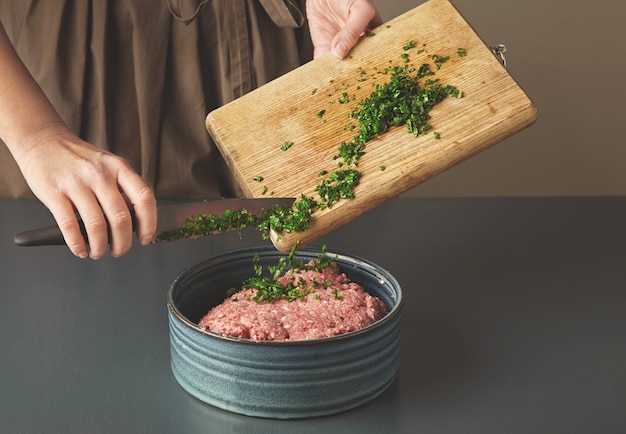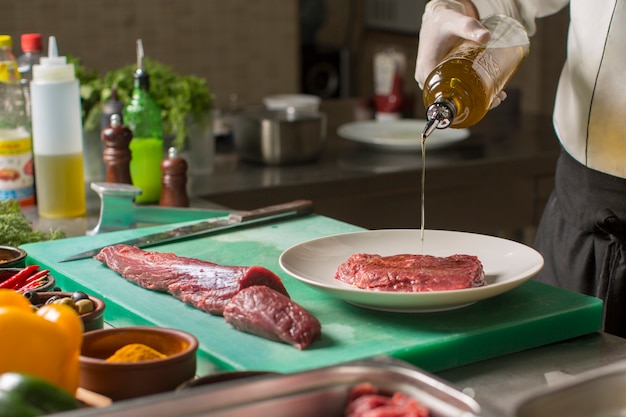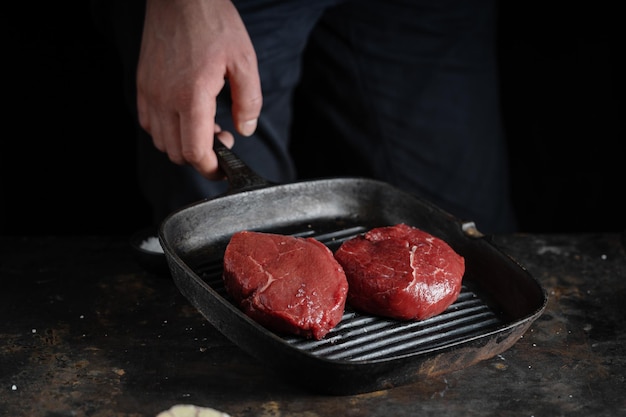Let's face it, we all love a good burger, a hearty chili, or a flavorful spaghetti sauce. But the foundation of all these delicious dishes is one simple ingredient: ground beef. And let me tell you, mastering the art of cooking ground beef is crucial to making those dishes truly sing. I'm not talking about those culinary school graduates with their fancy techniques. I'm talking about your average Joe like me, who just wants to whip up a delicious meal without ending up with dry, tough meat or worse, something that's not fully cooked. So, over the years, I've picked up some tips and tricks that I'd be happy to share with you. Ready to become a ground beef maestro? Let's dive in!
(Part 1) Understanding the Basics

Before we get into the specifics of cooking times and techniques, let's talk about the foundations. It all starts with understanding the different types of ground beef and how they behave differently in the pan. Plus, we need to get acquainted with the importance of internal temperature - that's the key to ensuring our beef is cooked through and safe to eat.
Different Types of Ground Beef: choosing the right cut
Ground beef isn't just ground beef, you know. There are various types, each with its own unique characteristics. Knowing the differences can make a world of difference in the final outcome of your dish.
- Ground Chuck: This is the classic, all-around choice. It's generally considered a good balance of leanness and fat content, resulting in juicy and flavorful results. Think of it as the "workhorse" of ground beef.
- Ground Sirloin: If you're looking for a leaner option, ground sirloin is your best bet. It's great for those who want to keep things light and less greasy. However, because it's leaner, it can dry out easily if you're not careful.
- Ground Round: This falls somewhere between chuck and sirloin in terms of fat content. It's a good all-purpose choice, working well in various dishes. It's a good middle ground if you're not sure which way to go.
- Ground Brisket: This is a very flavorful, fatty cut of beef. It's often used for making burgers because it adds incredible juiciness and depth of flavor. However, it can be a bit more challenging to cook because it requires a longer cooking time.
- Ground Short Rib: A true gourmet option, ground short rib is known for its rich, buttery flavor. It's best for dishes where you want to highlight the intense beefy taste, like a decadent burger or a flavorful chili.
To find the perfect type of ground beef for your needs, always check the packaging for the fat content. It's usually expressed as a percentage, with higher percentages indicating more fat.
The Importance of Internal Temperature: Ensuring Safety and Juiciness
Now, here's where things get a bit more technical. You see, ground beef is considered safe to eat when it reaches an internal temperature of 160°F (71°C). This means that all the potentially harmful bacteria have been killed. But it's not just about safety. Cooking ground beef to the correct temperature also ensures that it's juicy and tender, not dry and tough.
A good meat thermometer is a must-have for any home cook. It's a small investment that can save you a lot of trouble. No more guessing if your beef is done. Simply insert the thermometer into the thickest part of the meat and check the temperature.
(Part 2) Mastering the Stovetop: A Quick and Easy Approach

For most of us, the stovetop is the go-to for cooking ground beef. It's a quick, easy, and efficient method for everyday meals. But even here, there are a few tricks of the trade that can elevate your ground beef game to the next level.
Choosing the Right Pan and Heat: Laying the Foundation for Success
First, let's talk about the pan. A heavy-bottomed pan is essential for even heat distribution. This ensures that your ground beef cooks evenly and doesn't burn on the bottom. A cast iron skillet is a classic choice, but a good quality stainless steel pan will also work well.
Now, about heat. Medium heat is generally the sweet spot for cooking ground beef. It's hot enough to sear the outside of the meat and create a flavorful crust, but not so hot that it burns. You'll know you've got the heat right when a drop of water sizzles and evaporates quickly when added to the pan.
Breaking Up the Beef: A Gentle Touch is Key
As the ground beef cooks, you'll want to break it up into smaller pieces. You can use a wooden spoon, a spatula, or even a fork for this. But here's where a common mistake comes in: don't overwork it. Simply break up the meat into small pieces and leave it be. Over-stirring can cause the meat to release too much moisture, leading to dry and less flavorful results.
Draining the Excess Fat: A Matter of Preference
Once your ground beef is cooked, you might want to drain some of the excess fat. You can do this by tilting the pan and pouring the fat off into a separate container. But remember, a little bit of fat can actually add flavor and moisture to your dishes. It's up to you how much you want to drain, based on your preferences and the recipe you're making.
(Part 3) Cooking Times for Ground Beef: A Guide to Timing Perfection

Now we're getting to the heart of the matter: how long to cook ground beef. As you might have guessed, there's no one-size-fits-all answer. The cooking time depends on a few factors, including the type of ground beef, the quantity you're cooking, and whether you're just browning it or cooking it through.
Browning Ground Beef: Adding Flavor and Texture
Browning ground beef is all about giving it that beautiful brown color and crispy texture. It's essential for dishes like spaghetti sauce, tacos, or chili. You don't need to cook it all the way through when browning, just enough to get that lovely browned exterior.
Here's a rough guide for browning ground beef:
| Quantity | Cooking Time |
|---|---|
| 1 pound of ground beef | 5-7 minutes |
| 2 pounds of ground beef | 8-10 minutes |
Remember, these are just estimates. You'll need to adjust the cooking time based on the heat of your pan and the type of ground beef you're using. Keep a close eye on the meat and adjust the cooking time accordingly.
Cooking Ground Beef Through: Ensuring Safety and Tenderness
For dishes like burgers, meatloaf, or anything where the ground beef is the main ingredient, you'll need to cook it through to that safe internal temperature of 160°F (71°C). This ensures that the meat is fully cooked and safe to eat. It also helps to keep it tender and juicy.
Here's a general guide for cooking ground beef through:
| Quantity | Cooking Time |
|---|---|
| 1 pound of ground beef | 10-12 minutes |
| 2 pounds of ground beef | 15-20 minutes |
Once again, these are just guidelines. Always use a meat thermometer to check the internal temperature, especially for larger quantities of ground beef. It's better to be safe than sorry!
(Part 4) The Oven: A Different Approach for Even Cooking
For certain dishes, like meatloaf or burgers, the oven can be a great alternative to the stovetop. It provides a more even cooking environment and allows you to cook larger quantities of ground beef at once.
Preparing the Beef: Shaping it for Success
Before putting your ground beef in the oven, you'll need to shape it. For meatloaf, you can form it into a loaf shape. For burgers, you can form them into patties. You can even add seasonings like salt, pepper, garlic powder, or onion powder to the meat before shaping it for extra flavor.
Cooking Time and Temperature: Setting the Stage for Oven-Baked Goodness
The cooking time for ground beef in the oven depends on the size and thickness of the beef and the temperature of your oven. As a general rule, preheat your oven to 350°F (175°C) and bake for 20-25 minutes. Again, remember to use a meat thermometer to check the internal temperature. It's the best way to ensure that your beef is cooked through.
(Part 5) The Importance of Patience: Don't Rush the Process
Here's a confession: I used to be one of those impatient cooks who would try to rush the cooking process. I wanted to get dinner on the table as quickly as possible. But I learned the hard way that patience is key when cooking ground beef. If you try to cook it too quickly, you risk ending up with dry, tough meat.
Tips for Cultivating Your Inner Patience
Here's how to be patient and ensure your ground beef turns out perfectly:
- Use a Timer: Set a timer for the appropriate cooking time and let the meat cook undisturbed.
- Resist the Urge to Stir: Don't keep poking and prodding the beef. Give it space to cook evenly.
- Check the Internal Temperature: This is the ultimate indicator of whether the meat is cooked through.
(Part 6) Beyond the Basics: Taking Your Ground Beef Skills to the Next Level
Now that we've covered the essential basics of cooking ground beef, let's talk about some of the finer points that can take your skills to the next level. These are the things that can turn good ground beef cooking into truly exceptional results.
Using a Meat Thermometer: Your Culinary Compass
I know I've mentioned this before, but it's worth reiterating: a meat thermometer is your best friend when cooking ground beef. It takes all the guesswork out of cooking and ensures that your meat is cooked through to a safe internal temperature. It's a small investment that will pay off big time in terms of both safety and deliciousness.
Choosing the Right Fat Content: Tailoring Your Beef for Your Recipe
The fat content of ground beef can have a significant impact on the final outcome of your dish. Leaner ground beef, like sirloin or round, tends to cook faster and can dry out more easily. Fattier ground beef, like chuck or brisket, tends to cook more slowly and stay juicier.
So, for dishes where you want a leaner, lighter result, choose leaner ground beef. And for dishes where you want a rich, flavorful, and juicy result, choose fattier ground beef.
The Power of Seasoning: Adding Depth and Complexity
Don't underestimate the power of seasoning. Salt, pepper, garlic powder, onion powder, and other spices can elevate your ground beef to a whole new level of flavor. Experiment with different combinations to find what you like best. You can even add herbs, chili powder, paprika, cumin, or other spices to your ground beef to create unique flavor profiles.
Adding Veggies to the Pan: A Burst of Flavor and Nutrition
For extra flavor and nutritional value, consider adding chopped vegetables to the pan along with your ground beef. Onions, garlic, and bell peppers are classic choices. They add sweetness, savory notes, and a bit of texture to the dish. You can also experiment with other vegetables, like mushrooms, carrots, zucchini, or even potatoes.
(Part 7) Avoiding Common Mistakes: Learning from Experience
Everyone makes mistakes in the kitchen, and cooking ground beef is no exception. But by being aware of common pitfalls, you can avoid them and achieve delicious results every time.
Overcrowding the Pan: Giving Your Beef Space to Breathe
If you overcrowd the pan with too much ground beef, the meat won't cook evenly. Some pieces will end up well-done, while others will still be raw. You'll want to avoid this by cooking the ground beef in batches if necessary. Give each piece of meat room to brown properly.
Not Draining Excess Fat: A Matter of Taste
This is a matter of personal preference. Some people prefer their ground beef dishes to be a bit greasy, while others prefer them to be leaner. If you're not a fan of extra fat, you can drain some of it off after the meat is cooked. You can also choose a leaner type of ground beef for a less greasy outcome.
Undercooking the Beef: Ensuring Safety and Thorough Cooking
As I've mentioned, undercooked ground beef can be dangerous. Always use a meat thermometer to ensure that the internal temperature reaches 160°F (71°C). This will ensure that the meat is cooked through and safe to eat.
Overworking the Meat: A Gentle Touch is Key
Overworking the ground beef with a spatula or spoon can cause it to release a lot of its juices, making it dry. Break it up gently and resist the urge to stir constantly. Let the meat cook undisturbed for the best results.
(Part 8) FAQs: Common Questions Answered
Here are some frequently asked questions about cooking ground beef:
1. What's the Best Way to Tell if Ground Beef is Cooked Through?
The best way to tell is by using a meat thermometer. It should reach an internal temperature of 160°F (71°C). You can also check the color of the meat. Cooked ground beef should be brown all the way through, with no pink remaining.
2. What Happens if I Overcook Ground Beef?
Overcooked ground beef will be dry and tough. It will also lose its flavor and become less appealing. Try to avoid overcooking by using a meat thermometer and cooking the ground beef over medium heat.
3. Can I Cook Ground Beef in the Microwave?
Yes, you can cook ground beef in the microwave, but it's not the ideal method. The meat will often cook unevenly and can be dry. It's best to cook ground beef on the stovetop or in the oven for the best results.
4. How Long Can I Store Cooked Ground Beef in the Refrigerator?
Cooked ground beef can be stored in the refrigerator for up to 3-4 days. Be sure to refrigerate it promptly after cooking and store it in an airtight container.
5. Can I Freeze Cooked Ground Beef?
Yes, you can freeze cooked ground beef. It's best to freeze it in portions for easy use later. It can be stored in the freezer for up to 2-3 months. When thawing, it's best to thaw it in the refrigerator overnight.
And there you have it! I hope this guide has provided you with the knowledge and confidence to cook perfect ground beef every time. Remember, it's all about understanding the basics, having a bit of patience, and not being afraid to experiment in the kitchen. Now, go forth and create some delicious meals with your newfound expertise!
Everyone is watching

How to Cook Frozen Lobster Tails Perfectly: A Step-by-Step Guide
RecipesLobster. Just the word conjures up images of lavish meals, special occasions, and a taste of luxury. But let's...

Pigs in a Blanket Cooking Time: How Long to Bake for Perfect Results
RecipesAh, pigs in a blanket. Just the name conjures up images of those delightful little parcels of crispy pastry en...

Pork Fillet Cooking Time: How Long to Cook It Perfectly
RecipesPork fillet, or tenderloin as it's sometimes called, is a real favourite in our house. It's so versatile, and...

The Ultimate Guide to Cooking Delicious Frankfurters
RecipesLet's face it, we all love a good frankfurter. It's a classic, simple, and always satisfying. But let's be rea...

Wolf Meat Recipes: A Guide to Cooking Wild Game
RecipesLet's be honest, you don't see wolf meat at your local butcher shop every day. It's a bit of a wild card, but ...
